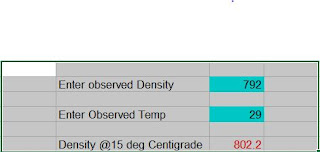- Carbon-Hydrogen Ratio & Calorific Values - A ready Reckoner - empowering field persons in plants
- Carbon-Hydrogen Ratio & Calorific Values - A ready Reckoner - empowering field persons in plants
Carbon - Hydrogen Ratio of petroleum products is of
prime importance because of it provides a quick means of finding out the
quality of same and suitability of use in various applications as feed to petrochemicals, fertilizer plants,
energy production etc. C/H ratio as well as Calorific Value of petroleum
products is dependent on specific gravity of products, a ready reckoner for
field persons can be developed. This empowers the plant
operating persons since they don’t have to now depend upon the laboratory to
get these values. A simple print out pinned on information board gives
immediately C/H ratio and Calorific Values only from density figure.
The Carbon Hydrogen ratio in hydrocarbons is
indicative of the hydrogen richness or deficiency.
These properties are specifically important to
Naphtha, a petroleum product similar to
Gasoline with respect to hydrocarbon content. Broadly Naphtha is classified as light naphtha and
heavy naphtha. Light Naphtha contain more hydrogen ( low C/H ratio and high
Calorific Value per unit mass ) and vice versa. Light Naphtha is
thus more useful for producing hydrogen for various use in fertilizer or in
hydrogen dependent processes. Heavy naphtha contains more Aromatics and have
high C/H ratio and low Calorific Value
per unit mass.
Calorific Value or Heat Content of petroleum products
is its measure of energy content and determined by various test methods like
Bomb Calorimeter ASTM D -240, IP 12 in laboratory. It’s estimated
satisfactorily using ASTM D- 6446. An alternative method as Aniline Gravity
Product is also very popular as per ASTM D-1405, IP 193. Another method ASTM
D-3338, heat of combustion is calculated from Density, Aromatics and
Distillation parameters.
The author here has simplified the technical issues with
practical assumption of normal other elements like Sulphur, Nitrogen, moisture
and other metallic impurities usually present in Naphtha and Residual Fuel Oil
and prepared a ready reckoner which estimates C/H ratio and Calorific
Values (both Gross as well as Net) in Tabular as well as a Nomo graph for
field as well as laboratory use. This work is based on Indian Standard 1448 – P
: 7 - Determination of Calorific values by Calculation.
Author's Profile




Comments